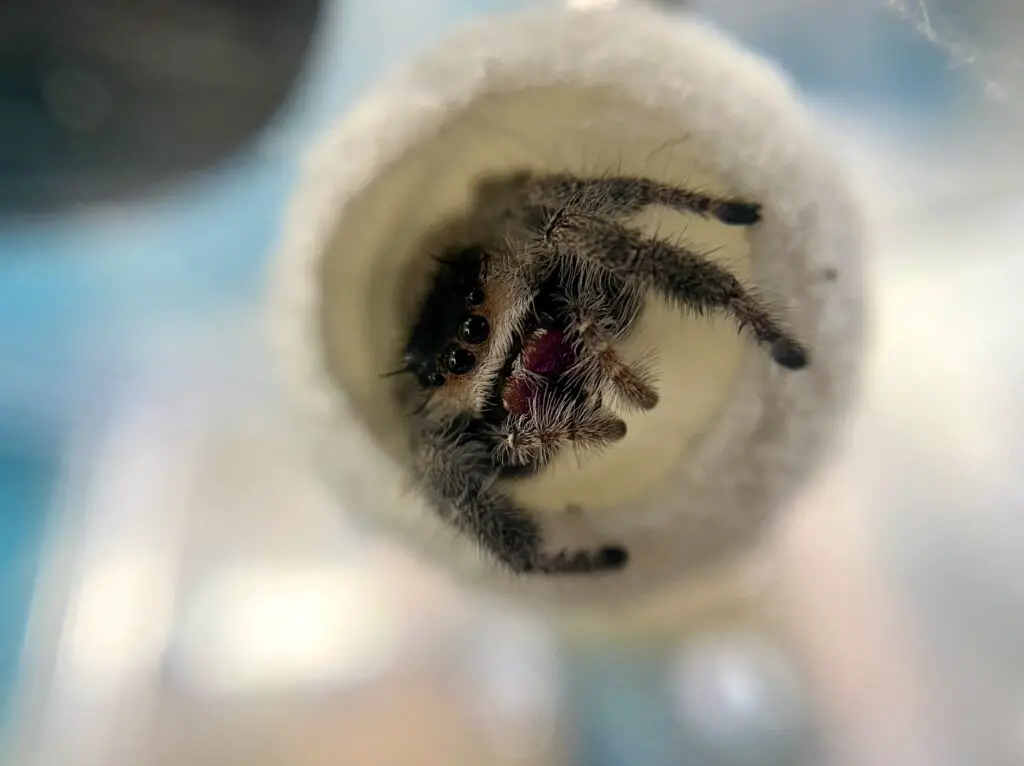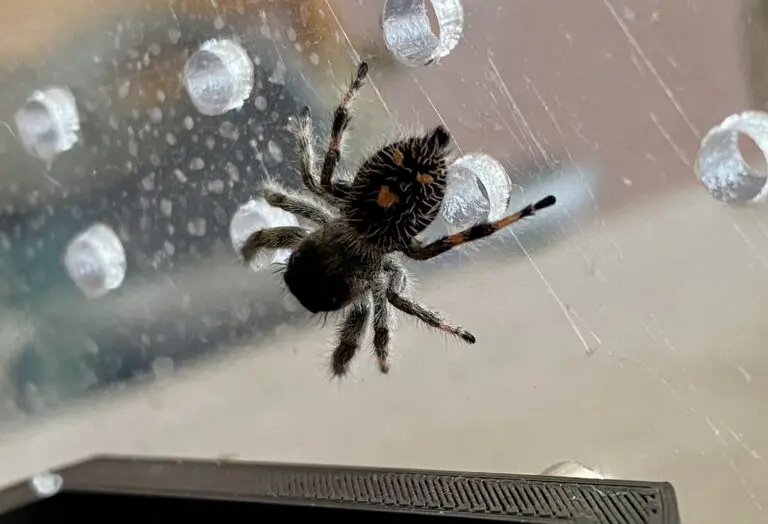Phidippus Regius
The phidippus regius, also known as P. regius or the regal jumping spider, is a member of the Salticidae family. The regal jumping spider belongs to the genus Phidippus, which is easily recognizable by their larger size and iridescent chelicerae.
Name
While scientifically known as phidippus regius, which can be translated to “the royal jumper”, this spider is commonly referred to as the regal jumper or regal jumping spider.
Geographical Range
Regal jumping spiders are most common in the Floridian peninsula, which is why the species is sometimes called the “Florida regal jumping spider.” Still, they can also be found in the Greater Antilles, the Bahamas, and the southern states of America. These specific locations show their climate preference: warm with relatively high humidity.
For P. regius jumping spiders kept in enclosures, it is important you replicate their preferred conditions within their home. This means keeping the temperature between 24-28C and around 50-60% humidity in the terrarium, or whatever enclosure type you use. Depending on your location, you can use heat mats with a thermostat and regular misting to meet the temperature and humidity required. You can buy gauges to help you monitor these conditions, too.
Conservation Status
The Florida regal jumping spider isn’t classified as endangered. They are generally common and widespread in their native habitats. However, habitat loss due to urbanization and pesticide use can pose threats to their populations. More research is needed to determine their exact conservation status.
Natural Habitat
Fields, open woodland, and semi-arid areas are widespread habitats for regal jumping spiders. Phidippus regius spiders will tend to avoid hardwood forests, however.
Subadult and adult regal jumping spiders are known to prefer palm fronds and semi-arid climates. This is due to the species preferring to hunt in areas with trees or on walls; the higher a jumping spider can get, the better vantage point it will have to spot prey. In more residential areas, you may also find them basking on walls or window frames when the sun is out.
Their preferred habitats help them throughout the various stages of their lives. For example, adult female regal jumpers will often build silken nests and lay their egg sacs under tree bark or in sheltered areas, like barns or sheds. This provides them with privacy and safety, both of which are essential to keep the egg sac – and later, spiderlings – safe.
For pet regal jumping spiders, you can use enclosure decor to create a natural habitat. This might include various items to climb, such as sticks, cork bark, and wooden ledges, as well as artificial or real plants. These pieces of decor will not only brighten up the enclosure, but they will also ensure the spider is stimulated by its surroundings. Many of these items can be bought online or at local pet stores, particularly if the pet store sells arachnids or reptiles.
Appearance
Ranging between 6-22mm in body length, the regal jumping spider is one of the largest species in eastern North America. Adult males range between 6-18 mm and fully-grown females tend to grow from 7 to 22 mm.
Similar to other jumping spider species, males and females can be identified by their appearance; this means they are sexually dimorphic. Male regal jumping spiders tend to be black and white, which can often lead to them being mixed up with the bold jumping spiders (phidippus audax). Females, on the other hand, have colored scales that can be a variety of colors; black, white, orange, red, gray, etc. Their coloring can change as they molt and mature. Simply put, a young spider might have a bright orange form, only to reach maturity and take on a gray form.
Both male and female phidippus regius jumpers can have colorful chelicerae. As previously mentioned, the chelicerae of regals are iridescent, meaning they can appear to change color. Green, blue-violet, and pink-purple are common colors of chelicerae for regal jumping spiders; the chelicerae of other species of the Phidippus genus are generally green.
One quirky detail can be found on a regal jumping spider’s abdomen; they have three spots that appear below a white band in the shape of a smiling face, almost like that of a pumpkin carving.
Lifespan
The average lifespan of the regal jumping spider is about a year. However, their lifespan can be increased with proper care if kept as a pet. Some jumping spider pets have been reported to live as long as three years.
Although phidippus regius jumping spiders do not usually suffer from health issues, you can try to prolong their lives by giving them the correct care. This includes regular feeding (but no overfeeding), the correct enclosure conditions, and biweekly misting for humidity and hydration.
Life Cycle
Jumping spiders, including phidippus regius, go through several life stages before reaching maturity. These stages are egg sac, spiderling, and adulthood.
The first stage in the regal jumping spider’s life cycle is the egg sac. Roughly the size of a grape, females of the species lay egg sacs under tree bark. An egg sac containing up to 300 eggs is laid after a successful mating. The female spider will remain near her eggs throughout the hatching process. After hatching, the spiderlings – or baby spiders – will remain in the egg sac until they have gone through their first molt.
Molting occurs throughout the second stage of a spider’s life until they reach maturity. This process helps them to keep growing as each molt allows them to shed their exoskeleton. Regal jumping spiders are known to molt at least five or six times before they are fully mature. Sometimes the frequency of food can affect how quick a jumping spider is to molt; this is due to its growth rate. A regal jumping spider who is fed more often will outgrow their exoskeleton quicker than one fed less.
Once mature, P. regius jumping spiders are in the third, and final, stage of the life cycle. They are adults, which also means they are ready to mate. Males often reach this stage quicker than females; they do not molt as frequently due to their smaller size. This is also when differentiating between males and females is much easier. Adult males will mate with any female they come across, and this is sometimes a completely different subspecies of jumping spider, but females are more choosy when it comes to their mate.
Behavior
Unsurprisingly, the regal jumping spider is an active hunter, preying on small insects and other spiders. Unlike other spiders, jumping spiders do not use webs to catch insects; their webs are used to build silken nests or hammocks. To hunt, they jump, hence the name. Their eyesight is excellent, meaning they can spot and track their prey easily. Then they will stalk their prey and pounce once they are within reach.
The regal jumping spider is also known for having impressive jumping ability in comparison to others in the family. Its Latin name, Phidippus regius, actually translates to “royal jumper”. These spiders can jump up to 40 times their own body length. When they jump, they extend their legs out in front of them and push off with their back legs. They then tuck their legs into their bodies and extend them out again, propelling them through the air.
But jumping is not the only way these spiders move around. They are also able to run, climb, and even “fly”. When they appear to “fly”, they are actually gliding on a silk thread that they produce. This is a safety measure in case they misjudge a jump and fall. These silk lines they produce are draglines, which they often use to stabilize and control themselves during a jump. Draglines stop spiders from falling and injuring themselves.
Although these spiders are predators, they not considered dangerous to humans as they are generally considered hesitant to bite, although a bite may cause some local swelling and discomfort. This hesitancy to be aggressive, or natural friendliness, might be one of the reasons regal jumpers are very popular pets; they are often the first jumping spider a person will own. It is also thought that regal jumping spiders can form a bond with their owner; they seem to recognize people, take an interest in changes around their enclosure, and are curious creatures who like to explore. Plus, phidippus regius jumping spiders can be rather low-maintenance pets, and their interesting behavior can be entertaining to watch.
Breeding and Mating Rituals
The mating rituals of the regal jumping spider are fascinating, and like many other jumping spiders, it includes a courtship dance by the male. The male regal jumping spider approaches the female cautiously, displaying his brightly colored pedipalps and waving his legs in a specific pattern. He also vibrates his abdomen to produce a sound that is unique to his species, which he amplifies using his web. The female, in turn, assesses the male’s display. If the display is not convincing enough, the female may turn aggressive and even attack the male.
After successful courtship, the female produces a silken egg sac where she lays her eggs, and guards it until the spiderlings are hatched. As mentioned earlier, a single egg sac can contain up to 300 eggs.
Adaptations
The regal jumping spider’s most distinctive adaptations are their eyes and legs. They have four pairs of eyes, with the anterior median pair being the largest. This set-up gives them a nearly 360-degree field of vision, allowing them to spot prey and predators with ease. Their large eyes are also incredibly sharp, aiding in their precise jumping attacks.
Their jumping ability is also a key adaptation. They have specialized leg muscles that allow them to leap great distances relative to their body size. This ability not only helps them to catch their prey, but also to evade potential predators and navigate their surroundings efficiently.
Diet
Regal jumping spiders are generalists when it comes to their diet. This means that they will eat just about anything they can catch. Their diet consists of mostly small insects, like ants and flies. However, if the opportunity arises, a regal jumping spider will not be opposed to eating other spiders; this is a risk for adult males during the mating process.
Phidippus regius spiders are able to survive for long periods of time without food. They can sometimes go for weeks without eating, as long as they have access to fresh water. This is due to the way their metabolism works.
Potential Role in Pest Control
Given their voracious appetite for insects, Florida regal jumping spiders could play a significant role in natural pest control. They can help manage populations of pests in gardens and farms without the use of harmful pesticides. However, more research is needed to fully understand their impact on pest populations and their potential role in integrated pest management strategies.
Interactions with Humans
Regal jumping spiders are generally harmless to humans. Their venom is not potent enough to cause serious harm, and they’re typically reluctant to bite unless threatened or provoked. Their bites may cause mild pain or itching, but these symptoms usually go away within a day or two.
Despite their harmless nature, some people are afraid of these spiders due to their large size and their jumping ability. On the other hand, many people find them fascinating and keep them as pets. As pets, they’re known to be relatively easy to care for and can even display a level of inquisitiveness toward their human caretakers.
Research and Interesting Facts
Research has shown that jumping spiders, including the regal jumping spider, are capable of learning, problem-solving, and even adapting their hunting strategies based on their experiences. This indicates a level of intelligence that is relatively high among invertebrates.
Interestingly, regal jumping spiders are known to display a phenomenon known as “mate-choice copying”. This is when a female spider is more likely to mate with a male if she has observed another female mating with him. This behavior has been observed in various other animals, but it’s especially interesting in spiders because of their solitary lifestyle.
In terms of appearance, the iridescent chelicerae of the regal jumping spiders have become the subject of study in the field of biomimetics, where scientists look to nature to inspire new technology. The ability of these spiders to produce and change colors might inspire new ways to create color in materials, without the use of harmful dyes or pigments.


